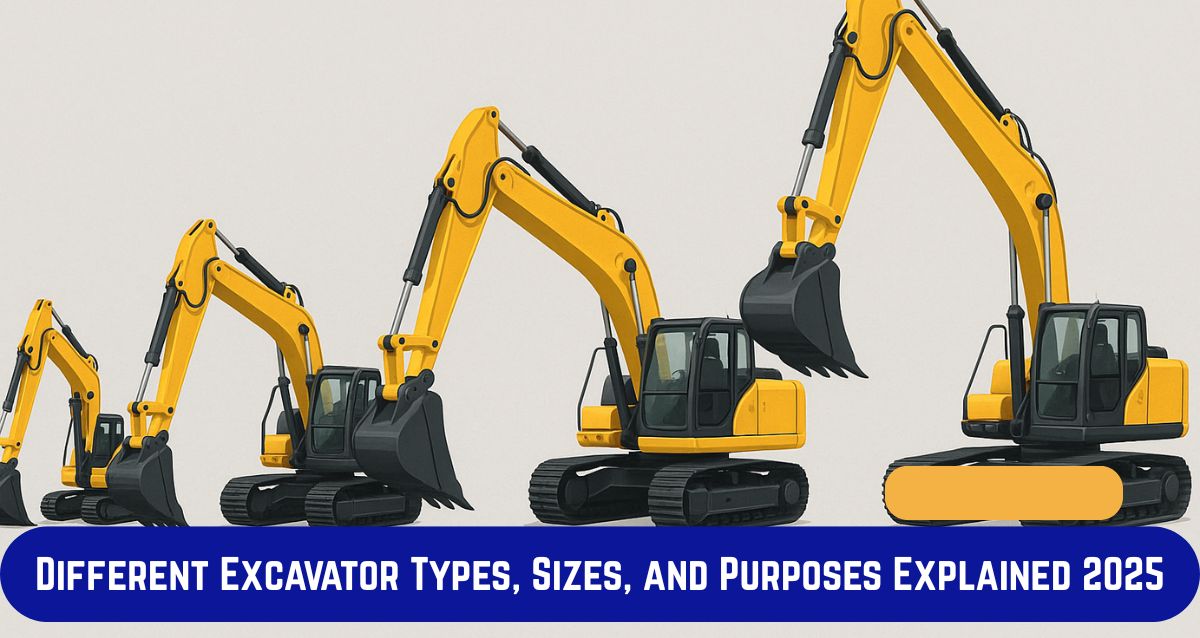Different Excavator Types, Sizes, and Purposes Explained 2025

Excavators do more than dig earth; they lift, move earth, shape terrain, and clear the way for what comes next. Whether you’re building a bridge, fixing a road, or breaking ground on a new home, there’s a machine for it.
And in 2025, the machines aren’t getting bigger—they’re getting smarter. You can’t bring a compact excavator to a mine. You don’t need a 50-ton crawler to trench in someone’s backyard. And with the right types of excavator buckets, even these small machines can take on detailed grading, trenching, and debris clearing.
Every machine tells a story. Every job has its own set of demands. Understanding how excavators differ—by type, size, and purpose—can save you more than time. It can protect workers and prevent damage. And if you get the wrong bucket? That one detail can change everything.
Crawler Excavators: The Workhorse on Tracks
Crawler excavators are the machines you want on a site where the ground won’t cooperate. These machines sit on wide tracks instead of wheels, which keeps them steady on muddy, soft, or uneven terrain. That stability makes them the preferred choice for digging deep, lifting heavy material, or working long hours without slipping or sinking.
You’ll see them in mining zones, bridge sites, and large commercial construction areas. They aren’t fast movers, but they’re built for power and balance. They can stay in one place and do the work others can’t do.
A crawler doesn’t stop because the ground gets messy. That’s the whole point. It was made for rough, imperfect conditions.
Wheeled Excavators: Best for Urban Speed and Smooth Surfaces
Where speed matters and roads stay paved, wheeled excavators offer a different kind of value. These machines are made for cities, streets, and hard surfaces. They move quickly between job sites and don’t damage asphalt or concrete as they go.
Instead of tracks, they run on rubber tires. That one change makes a big difference. Operators don’t have to haul them with trailers. They don’t need to clear the roads ahead. And with stabilizers down, they hold steady while digging or lifting.
You’ll often find them working on utility lines, road repairs, or sidewalk installations. They work in places where space is limited, and speed matters more than raw digging power.
Mini and Compact Excavators: Power in Tight Spaces
Not every job takes place on open land. Sometimes, machines need to squeeze through narrow gates, work beside houses, or navigate around fences. That’s where mini and compact excavators come in.
Long-Reach Excavators: Built for Distance
When the work can’t be done up close, long-reach excavators step in. These machines are equipped with extended booms that allow them to work from a distance. That reach makes them ideal for dredging rivers, clearing canals, or reaching across demolition sites.
Safety is a big reason they exist. Operators can stay far from unstable ground or deep trenches while still doing the job effectively. Long-reach models don’t come into play on every site, but when distance is part of the challenge, nothing else works quite the same.
They aren’t about speed or flexibility. They’re about reaching the point where the work begins—even when it’s far from where the machine sits.
Suited to the Job: Excavator Sizes Explained
Every excavator has a size classification based on its operating weight. These classifications help match machines to the demands of the job and the constraints of the site.
- Mini excavators (under 10 tons): Ideal for small, light-duty jobs like residential projects, trenching, and landscaping.
- Medium excavators (10 to 45 tons): Fit for most commercial construction, infrastructure work, and utility projects.
- Large excavators (over 45 tons): Reserved for the biggest tasks—mining, deep foundation work, and demolition.
Choosing a machine that’s too large for a confined area wastes fuel and risks property damage. Picking one too small for the load can cause delays or breakdowns. Size isn't about status. It's about fit. That’s what keeps a job running smoothly and safely.
Matching Jobs with the Right Types of Excavator Buckets
The bucket isn’t an afterthought. It’s what makes the machine valuable. Different types of excavator buckets are built for specific materials, shapes, and depths. Using the wrong one can slow a job down or even damage the site.
- Standard buckets are designed for everyday digging and lifting.
- Trenching buckets are narrower and made to cut deep, clean lines for pipe or cable placement.
- Rock buckets are reinforced for hard surfaces and sharp materials.
- Tilt buckets can angle to the side, which makes grading and slope work much easier.
- Clean-up buckets are wider and shallow, used to finish the job and remove loose debris.
The correct bucket saves time. It also saves effort. Workers don’t have to compensate for the wrong cut, the wrong depth, or the wrong load. That makes the whole job safer and more predictable.
Industries and Use Cases: Excavators in Action
Excavators show up almost everywhere, and heavy work is being done. And they take on different roles depending on the industry.
- In construction, they dig foundations, load material, and tear down old structures.
- In mining, they move rock, reach into pits, and haul out debris using stronger builds and reinforced types of excavator buckets.
- Forestry crews use them to lift logs and clear stumps with specialized grapples.
- Utility contractors depend on smaller machines to lay pipes, repair lines, and avoid damaging existing infrastructure.
- In demolition, heavy-duty excavators crush, tear, and sort rubble from steel and concrete.
One machine does not fit all. Each task needs the right power, size, and configuration. That’s how projects stay on schedule and budget.
Future Trends in Excavators: What’s New in 2025?
Excavators in 2025 are built to be smarter, safer, and easier to control. New models focus on operator comfort, fuel efficiency, and precision. They offer better visibility, touchscreen controls, and hydraulic systems that adjust in real-time.
Hybrid and electric machines are growing more common, especially in city zones where noise or emissions are a concern. Automation features are being added, too—systems that stop the boom at the correct depth or level the grade without needing extra passes.
Buckets are changing as well. New materials and designs allow faster swaps and longer lifespans. That means crews spend less time switching tools and more time finishing work.
These changes don’t make the job easier. They make it cleaner. Safer. And more consistent.
Conclusion
Excavators are no longer simple digging machines. They’ve evolved to meet the specific demands of every job site, every material, and every project size. Choosing the right one takes more than glancing at specs. It means knowing your terrain, your deadlines, and your crew.
The types of excavator buckets you use can decide whether a trench is clean and exact or messy and redone. The machines are ready, the technology is in place, and the decisions are yours. Pick what fits the work—not what fits the brochure.
Note: IndiBlogHub features both user-submitted and editorial content. We do not verify third-party contributions. Read our Disclaimer and Privacy Policyfor details.







